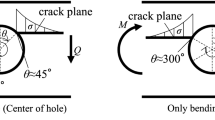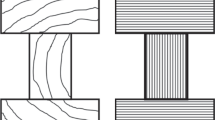Abstract
The load bearing capacity of glued laminated timber beams is size dependent. A material based size effect occurs due to the natural variability of the timber properties and can be explained with the Weibull weakest link theory. The Weibull type size effect has received much attention in the timber research community in the past as it is the dominating size effect regarding the load bearing capacity of timber beams. In this paper, it is shown that a further deterministic size effect, which originates from the timber fracture behavior, influences the load bearing capacity of glued laminated timber beams. It is the size effect associated with quasi-brittle behavior. The paper covers a short theoretical review on fracture related size effects and a study comparing experimentally tested beams of several sizes with detailed numerical simulations considering the natural growth characteristics of timber. Further, an analytical model illustrating the features of the fracture related size effect on the load bearing capacity of glued laminated timber beams is presented. It is demonstrated that the simulated load bearing capacity of the tested glued laminated timber beams distinctively improves if the quasi-brittleness is taken into account by using a softening constitutive law.














Similar content being viewed by others
Abbreviations
- a :
-
Depth of failure region
- \(a_0\) :
-
Depth of initial crack
- b :
-
Width of the specimen
- d :
-
Size, any dimension
- \(d_0\) :
-
Size (length) of the fracture process zone
- f :
-
Load bearing capacity (bending strength)
- \(f_{\rm pl}\) :
-
Plastic limit state load bearing capacity
- \(f_{\rm t}\) :
-
Tensile strength; fracture initiation stress
- h :
-
Height of the specimen
- k :
-
Slope of the failure region
- l :
-
Length of the specimen
- m :
-
Slope ratio of the softening branch
- r :
-
Distance from the crack-tip
- t :
-
Timber board thickness; time
- E :
-
Modulus of elasticity
- F :
-
Limit state function
- \(G_{\rm f}\) :
-
Fracture energy
- K :
-
Stress intensity factor
- \(K_{\rm c}\) :
-
Fracture toughness
- \(L_{\rm f}\) :
-
Length of failure region
- \(L_{\rm cr}\) :
-
Hillerborg’s critical length
- M :
-
Bending moment
- \(M_{\rm el}\) :
-
Elastic bending resistance
- \(\delta\) :
-
Separation or virtual crack width
- \(\delta _{\rm r}\) :
-
Crack width at complete separation
- \(\kappa\) :
-
Attained maximum level of strain
- \(\sigma\) :
-
Stress
- \(\varepsilon\) :
-
Strain
- \(\varepsilon _{\rm u}\) :
-
Strain at failure
- \(\tilde{\varepsilon }\) :
-
Smeared strain
- \(\tilde{\varepsilon }_{\rm r}\) :
-
Smeared strain at complete separation
- \(\omega\) :
-
Damage variable
- \(\chi\) :
-
Curvature
References
Aicher S (1992) Fracture and size effect law for spruce and oak in mode I and mixed mode I and II. In: Proceedings of the RILEM TC133 meeting. LRBB, Bordeaux, France
Aicher S (2010) Process zone length and fracture energy of spruce wood in mode-I from size effect. Wood Fiber Sci 42(2):237–247
Aicher S, Reinhardt H (1993) Einfluss der Bauteilgrösse in der linearen und nichtlinearen (Holz-) Bruchmechanik [Influence of the component size according to linear and non-linear (wood-) fracture mechanics]. Eur J Wood Prod 51(3):215–220
Aicher S, Reinhardt H, Klöck W (1993) Nichtlineares Bruchmechanik-Maßstabsgesetz für Fichte bei Zugbeanspruchung senkrecht zur Faserrichtung [Non linear fracture mechanics size effect law for spruce in tension perpendicular to grain]. Eur J Wood Prod 51(6):385–394
Aicher S, Boström L, Gierl M, Kretschmann D, Valentin G (1997) Determination of fracture energy of wood in mode II—RILEM TC 133 report. Technical report, SP Swedish National Testing and Research Institute, Borås, Sweden
Anderson TL (2005) Fracture mechanics: fundamentals and applications. CRC Press, Boca Raton
Bažant ZP (1976) Instability, ductility, and size effect in strain-softening concrete. J Eng Mech Div 102(2):331–344
Bažant ZP (1984) Size effect in blunt fracture: concrete, rock, metal. J Eng Mech 110(4):518–535
Bažant ZP (1987) Fracture energy of heterogeneous material and similitude. In: Proceedings of the SEM-RILEM international conference on fracture of concrete and rock, Houston, Texas, SEM, pp 390–402
Bažant ZP (2001) Size effects quasibrittle fracture: apercu of recent results. In: Proceedings of the fourth international conference on fracture mechanics of concrete and concrete structures, Cachan, France, pp 651–658
Bažant ZP (2002) Scaling of structural strength. Hermes-Penton, London
Bažant ZP, Chen EP (1997) Scaling of structural failure. Appl Mech Rev 50(10):593–627
Bažant ZP, Li Z (1995) Modulus of rupture: size effect due to fracture initiation in boundary layer. J Struct Eng 121(4):739–746
Bažant ZP, Planas J (1998) Fracture and size effect in concrete and other quasibrittle materials. CRC Press, Boca Raton
Benabou L, Sun Z (2015) Numerical study of anisotropic failure in wood under large deformation. Mater Struct 48(6):1977–1993
Blaß H, Frese M, Glos P, Denzler J, Linsenmann P, Ranta-Maunus A (2009) Zuverlässigkeit von Fichten-Brettschichtholz mit modifiziertem Aufbau [Reliability of spruce glulam with modified setup], Bd. 11. Karlsruher Berichte zum Ingenieurholzbau Universitätsverlag Karlsruhe, Germany
Daudeville L (1999) Fracture in spruce: experiment and numerical analysis by linear and non linear fracture mechanics. Eur J Wood Prod 57(6):425–432
Dorn M (2015) A combined material model for plasticity and fracture for wood. In: Proceedings of the EUROMECH Colloquium 556 on theoretical, numerical, and experimental analyses in wood mechanics, Dresden, Germany, pp 14–15
EN 1194 (1999) Timber structures—glued laminated timber, strength classes and determination of characteristic values; German version EN 1194:1999
Fink G (2014) Influence of varying material properties on the load-bearing capacity of glued laminated timber. Ph.D. thesis, ETH Zurich, Institute of Structural Engineering IBK, Nr. 21746, Switzerland
Fink G, Kohler J (2014) Model for the prediction of the tensile strength and tensile stiffness of knot clusters within structural timber. Eur J Wood Prod 72(3):331–341
Fink G, Kohler J (2015) Probabilistic modelling of the tensile related material properties of timber boards and finger joint connections. Eur J Wood Prod 73(3):335–346
Fink G, Kohler J, Frangi A (2013) Bending tests on glued laminated timber beams with well-known material properties, IBK report No. 350. Technical report, ETH Zurich, Switzerland
Fink G, Frangi A, Kohler J (2015a) Bending tests on GLT beams having well-known local material properties. Mater Struct 48:3571–3584. doi:10.1617/s11527-014-0424-2
Fink G, Frangi A, Kohler J (2015b) Probabilistic approach for modelling the load-bearing capacity of glued laminated timber. Eng Struct 100:751–762
Füssl J, Lukacevic M, Kandler G, Eberhardsteiner J (2014) A comprehensive mechanical modeling approach for the design of wood-based products. Bull Int Assoc Comput Mech 35:8–13
Gebhardt C, Kaliske M (2015) Fracture simulation of timber structures using xfem. In: Proceedings of the EUROMECH Colloquium 556 on theoretical, numerical, and experimental analyses in wood mechanics, Dresden, Germany, pp 16–17
Görlacher R (1990) Sortierung von Brettschichtholzlamellen nach DIN 4074 durch Messung von Longitudinalschwingungen [Grading of glued laminated timber boards according to DIN 4047 through measurement of the longitudinal oscillation]. Bauingenieur 65(11):517–522
Guindos P, Guaita M (2013) A three-dimensional wood material model to simulate the behavior of wood with any type of knot at the macro-scale. Wood Sci Technol 47(3):585–599
Gustafsson PJ (1985) Fracture mechanics studies of non-yielding materials like concrete: modelling of tensile fracture and applied strength analyses. Ph.D. thesis, Lund University, Sweden
Hillerborg A, Modéer M, Petersson PE (1976) Analysis of crack formation and crack growth in concrete by means of fracture mechanics and finite elements. Cem Concr Res 6(6):773–781
Isaksson T (1999) Modelling the variability of bending strength in structural timber—length and load configuration effects. Ph.D. thesis, Lund University, Sweden
Jenkel C, Kaliske M (2014) Finite element analysis of timber containing branches—an approach to model the grain course and the influence on the structural behaviour. Eng Struct 75:237–247
Larsen H, Gustafsson P (1990) The fracture energy of wood in tension perpendicular to grain - results from a joint testing project. In: Proceedings of the CIB-W18 meeting 23, Lisbon, Portugal, CIB-W18A/23-19-2
Leicester RH (1969) The size effect of notches. In: Proceedings of the 2nd Australasian conference on the mechanics of structures and materials, Melbourne, Australia
Lukacevic M, Fnssl J (2014) Numerical simulation tool for wooden boards with a physically based approach to identify structural failure. Eur J Wood Prod 72(4):497–508
Lukacevic M, Füssl J, Lampert R (2015) Failure mechanisms of clear wood identified at wood cell level by an approach based on the extended finite element method. Eng Fract Mech 144:158–175
Madsen B et al (1992) Structural behavior of timber. Timber Engineering Ltd, Vancouver
Morel S, Valentin G (1996) Size effect in crack shear strength of wood. Le Journal de Physique IV 6(C6):C6–385
Olsson A, Oscarsson J (2014) Three dimensional fibre orientation models for wood based on laser scanning utilizing the tracheid effect. In: Proceedings of the World conference on timber engineering, WCTE, Quebec City, Canada
Qiu L, Zhu E, Van de Kuilen J (2014) Modeling crack propagation in wood by extended finite element method. Eur J Wood Prod 72(2):273–283
Sandhaas C, Van de Kuilen JW, Blass HJ (2012) Constitutive model for wood based on continuum damage mechanics. In: Proceedings of the World conference on timber engineering. WCTE, Auckland, New Zealand
Schickhofer G, Pischl R, Seiner C, Steinberger A, Gehri E, Mauritz R (1995) Development of efficient glued-laminated timber with the application of mechanical stress-graded timber. Summary of the FFF-Research Project, Graz-Zurich-Vienna 36
Schmidt J, Kaliske M (2009) Models for numerical failure analysis of wooden structures. Eng Struct 31(2):571–579
Serrano E, Gustafsson PJ (2006) Fracture mechanics in timber engineering-strength analyses of components and joints. Mater Struct 40(1):87–96
Smith I (2003) Fracture and fatigue in wood. Wiley, New York
Weibull W (1939) A statistical theory of the strength of materials, vol 151. Generalstabens litografiska anstalts förlag, Stockholm
Acknowledgements
The authors thank Claude Leyder for her most valuable contributions during the preparation of this paper.
Author information
Authors and Affiliations
Corresponding author
Rights and permissions
About this article
Cite this article
Blank, L., Fink, G., Jockwer, R. et al. Quasi-brittle fracture and size effect of glued laminated timber beams. Eur. J. Wood Prod. 75, 667–681 (2017). https://doi.org/10.1007/s00107-017-1156-0
Received:
Published:
Issue Date:
DOI: https://doi.org/10.1007/s00107-017-1156-0




